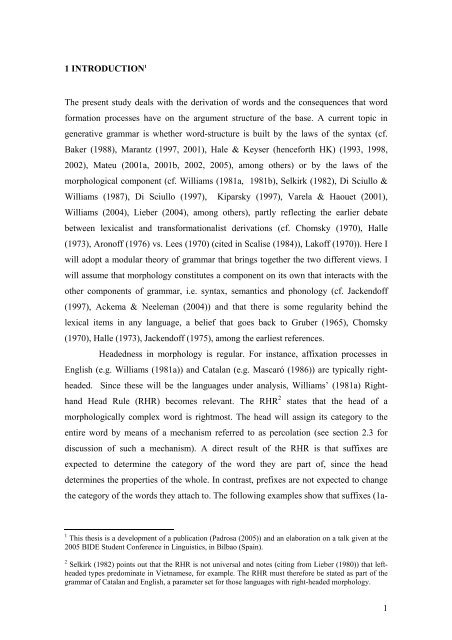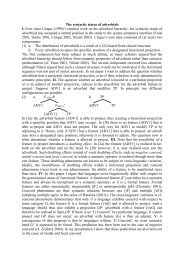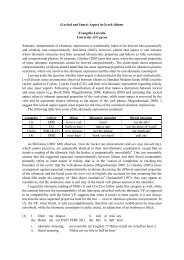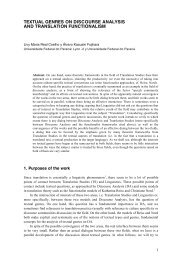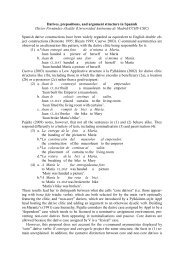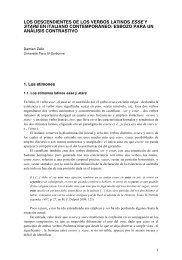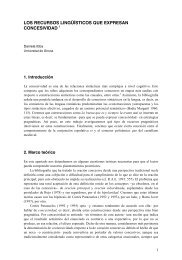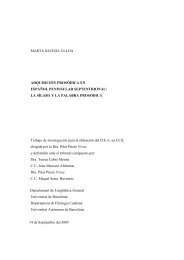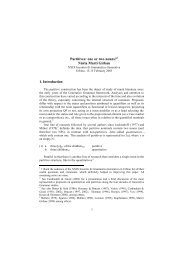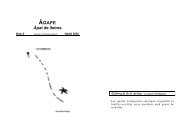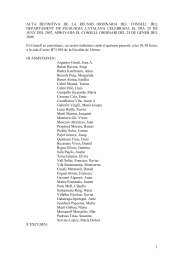Prefixation in English and Catalan - Departament de Filologia ...
Prefixation in English and Catalan - Departament de Filologia ...
Prefixation in English and Catalan - Departament de Filologia ...
Create successful ePaper yourself
Turn your PDF publications into a flip-book with our unique Google optimized e-Paper software.
1 INTRODUCTION 1<br />
The present study <strong>de</strong>als with the <strong>de</strong>rivation of words <strong>and</strong> the consequences that word<br />
formation processes have on the argument structure of the base. A current topic <strong>in</strong><br />
generative grammar is whether word-structure is built by the laws of the syntax (cf.<br />
Baker (1988), Marantz (1997, 2001), Hale & Keyser (henceforth HK) (1993, 1998,<br />
2002), Mateu (2001a, 2001b, 2002, 2005), among others) or by the laws of the<br />
morphological component (cf. Williams (1981a, 1981b), Selkirk (1982), Di Sciullo &<br />
Williams (1987), Di Sciullo (1997), Kiparsky (1997), Varela & Haouet (2001),<br />
Williams (2004), Lieber (2004), among others), partly reflect<strong>in</strong>g the earlier <strong>de</strong>bate<br />
between lexicalist <strong>and</strong> transformationalist <strong>de</strong>rivations (cf. Chomsky (1970), Halle<br />
(1973), Aronoff (1976) vs. Lees (1970) (cited <strong>in</strong> Scalise (1984)), Lakoff (1970)). Here I<br />
will adopt a modular theory of grammar that br<strong>in</strong>gs together the two different views. I<br />
will assume that morphology constitutes a component on its own that <strong>in</strong>teracts with the<br />
other components of grammar, i.e. syntax, semantics <strong>and</strong> phonology (cf. Jackendoff<br />
(1997), Ackema & Neeleman (2004)) <strong>and</strong> that there is some regularity beh<strong>in</strong>d the<br />
lexical items <strong>in</strong> any language, a belief that goes back to Gruber (1965), Chomsky<br />
(1970), Halle (1973), Jackendoff (1975), among the earliest references.<br />
Hea<strong>de</strong>dness <strong>in</strong> morphology is regular. For <strong>in</strong>stance, affixation processes <strong>in</strong><br />
<strong>English</strong> (e.g. Williams (1981a)) <strong>and</strong> <strong>Catalan</strong> (e.g. Mascaró (1986)) are typically righthea<strong>de</strong>d.<br />
S<strong>in</strong>ce these will be the languages un<strong>de</strong>r analysis, Williams’ (1981a) Righth<strong>and</strong><br />
Head Rule (RHR) becomes relevant. The RHR 2 states that the head of a<br />
morphologically complex word is rightmost. The head will assign its category to the<br />
entire word by means of a mechanism referred to as percolation (see section 2.3 for<br />
discussion of such a mechanism). A direct result of the RHR is that suffixes are<br />
expected to <strong>de</strong>term<strong>in</strong>e the category of the word they are part of, s<strong>in</strong>ce the head<br />
<strong>de</strong>term<strong>in</strong>es the properties of the whole. In contrast, prefixes are not expected to change<br />
the category of the words they attach to. The follow<strong>in</strong>g examples show that suffixes (1a-<br />
1 This thesis is a <strong>de</strong>velopment of a publication (Padrosa (2005)) <strong>and</strong> an elaboration on a talk given at the<br />
2005 BIDE Stu<strong>de</strong>nt Conference <strong>in</strong> L<strong>in</strong>guistics, <strong>in</strong> Bilbao (Spa<strong>in</strong>).<br />
2 Selkirk (1982) po<strong>in</strong>ts out that the RHR is not universal <strong>and</strong> notes (cit<strong>in</strong>g from Lieber (1980)) that lefthea<strong>de</strong>d<br />
types predom<strong>in</strong>ate <strong>in</strong> Vietnamese, for example. The RHR must therefore be stated as part of the<br />
grammar of <strong>Catalan</strong> <strong>and</strong> <strong>English</strong>, a parameter set for those languages with right-hea<strong>de</strong>d morphology.<br />
1


